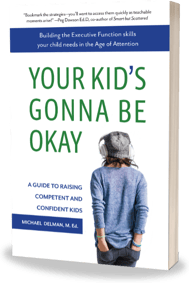Do you ever run into the grocery store with a short list in your head and leave with only half of  what you went in for? Does your son have to memorize the names of the planets in order, numerical operations, science classifications, or the beaches of the Normandy D-Day invasion - and does he always forget one or two? Does your daughter “cram” the night before a vocabulary quiz by repeatedly reading over the list and then forget everything she “learned” the night before, at test time?
what you went in for? Does your son have to memorize the names of the planets in order, numerical operations, science classifications, or the beaches of the Normandy D-Day invasion - and does he always forget one or two? Does your daughter “cram” the night before a vocabulary quiz by repeatedly reading over the list and then forget everything she “learned” the night before, at test time?
All of these scenarios require memory, a skill that is tested throughout our entire day. I often support the use of technology to help with many Executive Function skills and tell my students that using these tools helps decrease the short term or working memory load to free up room in the brain for other things they actually want to remember. As much as I love technology, there are some downfalls to its use. For example, what happens when the technology is not available, say when it loses power or when a student is taking a test and can’t access their go-to app? Since memory is a skill that is essential to completing both academic work and independent living skills, it is beneficial to learn strategies to memorize information more effectively without the use of technology.
I can honestly count on one hand the number of phone numbers I still have memorized from before I got a cell phone as a teenager. I can promise you that I would be completely lost without the contacts in my cell phone. If I wanted to memorize new contact numbers (or other strings of information such as my credit card number to facilitate online shopping), I would use the same skill I did as a child; chunking information. Chunking is taking large strings of numbers, letters or words and grouping them into smaller components so it is more easily remembered. Often, this information is stored in our working memory, but it is possible if the chunks are used enough it will move to long term memory. If you think about key information, such as credit card or social security numbers, we often give this information in chunks. My students are floored when I tell them I used chunking to remember phone numbers, so I give them the more relevant example of chunking information to remember a security code to reset a password. Instead of remembering the arbitrary code 1892557913, I would chunk this into 189 255 7913. I only have to remember 3 pieces of information instead of 10. When I spell my last name for others it is always “SCH-EL-HORN” so it is easier for the other person to record my information. Functionally, chunking can also be used to organize lists of information that may be unrelated.
A quick and efficient memory strategy is repetition or rehearsing information verbally. Repeating information to yourself helps to memorize a small list of items (about 5-7), especially when paired with a physical gesture such as ticking off your fingers. Repeating information moves it to short term memory, which is good for more immediate recall such as the trip to the grocery store or to a locker to pack up at the end of the day. With practice, this list can also move to long term memory. For example, I love to use this strategy to support kids who forget to bring all their items with them each day. A simple check for phone, wallet, keys, lunchbox and coat before they head out the door can avoid problems later in the day. In order for this strategy to be successful, it is important to keep rehearsing items until you are asked to retrieve the information, as research shows repeated quizzing results in more recall after a week delay.
A third helpful memory strategy is mnemonics or memory devices. There are many different ways to use mnemonics, such as word associations, making an acronym or drawing a picture to facilitate a connection in the brain. The key to mnemonics is that it is driven by the person who needs to remember the information. For example, when helping one student memorize the parts of the cell, I suggested to her the word association lysol to remember the “cleaning” function for lysosomes. When looking at the picture of the inside of a cell, however, she thought lysosomes looked like a bowl of soup, so her mnemonic instead became lysosoup. Her mnemonic proved to be effective, as she earned a 100% on her quiz.
Acronyms are also helpful in creating mnemonics. To make an acronym, simply take the first letter of the words to remember and join them together to form a new word. It is possible to take it one step further and make a sentence out of your acronym as an additional memory device. I may not need to use algebra much anymore, but I do still remember what PEMDAS means (Parentheses, Exponents, Multiplication, Division, Addition, Subtraction) thanks to the sentence I learned in middle school: Please Excuse My Dear Aunt Sally. Again, our brains remember best when we form the connections ourselves, so having your child generate their mnemonic can be a fun part of the studying process.
As with any skill, with a little practice, you (and your child) can memorize more effectively!
Photo credit: Shutterstock
Looking for more parenting tips and strategies to help your child be successful in school and beyond? Michael Delman's book Your Kid's Gonna Be Okay: Building the Executive Function Skills Your Child Needs in the Age of Attention is now available for pre-order. Download a free excerpt below.


